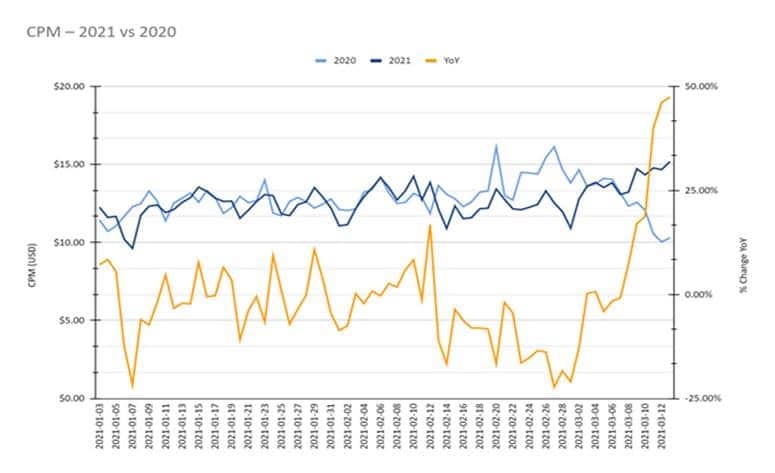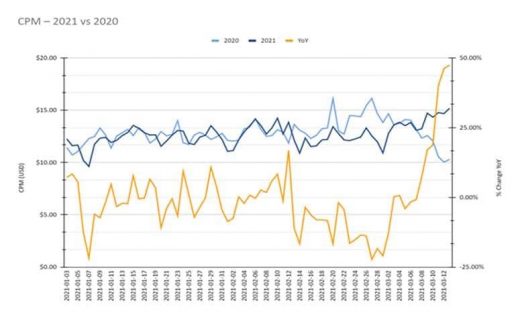CDPA differences, Social CPMs, Martech Replacement Survey: Friday’s daily brief
Plus, is everybody cool with AI?
Marketing Land’s daily brief features daily insights, news, tips, and essential bits of wisdom for today’s digital marketer. If you would like to read this before the rest of the internet does, sign up here to get it delivered to your inbox daily.
Good morning, Marketers, and today it’s all about the details.
GDPR, CCPA…now, CDPA. I used to be a big fan of alphabet soup. But now it seems every time the spoon goes in, a new set of practices have to be swallowed. Since we are detail-oriented journalists here, serving a community of detail-oriented marketing chef wizards, please enjoy another course below from Joe Stanganelli, our expert on the latest legislative twists and turns in privacy compliance.
After compliance, everything else can go down easier. Marketers and the consumers they converse with can relax and welcome smoother sailing ahead. At least, that’s how the data looks when comparing CPMs on social advertising. Exclusive metrics from SticherAds remind us, below, that even when, in our guts, some anxiety has been lifted, as we eat up the warmer weather and indoor seating, we should always read the fine print on the menu.
We can also depend on trusted sources and technology to scale our understanding of the important details. Further below, you’ll also find that trust levels for AI technology are at pretty high levels. But it’s nuanced, just like the nuances in a conversation that you would expect an AI conversational solution to adhere to when providing your customers with first-rate experiences.
And please don’t hesitate to join us around the table by taking our Martech Replacement Survey.
Chris Wood,
Editor
Key differences between CDPA and CCPA
This month, the Consumer Data Protection Act (CDPA) became law in Virginia — although it will not go into effect until 2023. As the latest example of sweeping, comprehensive state data-protection law, CDPA has drawn a lot of rough comparisons among pundits between itself and its Californian cousin — the California Consumer Privacy Act (CCPA).
In fairness, the two have a lot of similarities. They both largely grant consumers’ rights to obtain, know about, and delete their data — as well as opt out of further processing of their personal data. They both offer a base 30-day cure period to businesses in the event of a violation. And they both require companies to take certain information-security steps. But there are a lot of differences as well.
Among the key differences are the scope of the businesses to which the laws apply; the way in which publicly available data is exempted; and the scale and severity of penalties. Marketers and data processors need to understand how to comply with each of these laws.
Tell us how you’ve tweaked, or overhauled, your stack
A lot of things have changed over the last year, including of course for marketing and marketing ops teams. Martech is only one element in this shifting landscape, of course, but it’s an important one. Digital transformation, which has become much more than a buzz phrase, has surely required many marketing teams to elevate their technology stack. That might mean leaning into solutions that can get up and running and deliver value quickly. It might mean accelerated innovation in the tech stack. Some companies might be under strict budget constraints, while others might have felt that 2020 was the year to bet the house.
We’d like to dig deeper into how the business environment over the last 12 months impacted martech decisions, but we need your help. Have you replaced any applications in your tech stack in the past year? Have you moved from homegrown legacy applications to commercial solutions (or vice versa)? And what impact have those changes had on your team? Please spend just three minutes to complete the Martech Replacement Survey. It will help us all, as a community of martech users and martech watchers, to understand how what Microsoft’s Satya Nadella called “two years of digital transformation in two months” looks like over the whole of the last year.
2021 v. 2020 on social channels

With vaccines and stimulus checks rolling out, this year is set to be significantly different from last year in many ways. But how different? And what does this mean, specifically, for marketers who use social media?
New data from ads solutions and shopping experiences platform StitcherAds tells the story from the perspective of ad investments in social. StitcherAds helps drive incremental sales for major brands who advertise on Facebook, Instagram, Pinterest and Snapchat. They analyzed CPMs across dozens of client campaigns between this year and 2020.
Beginning March 7 of this year, the data shows a significant spike in CPMs — as high as 47% up from this time last year. Of course, this has to do with how advertisers pulled back in 2020 once the reality of the pandemic hit marketers. Major brands reduced their spend, sending prices down.
StitcherAds also finds that the coronavirus relief package signed this year is having an impact on social advertising.
As a result of the $1.9 trillion stimulus package and $1,400 checks, StitcherAds Director of Strategy Bryan Cano said “brands throughout the country considered activating additional budgets for performance marketing channels like paid social.”
He added, “In fact, the weekend following the stimulus package, we saw some brands report improvement of ROAS of up to 25% compared to their three-day average.”
Why we care. As the stark differences between 2021 and 2020 make clear, conventional wisdom about some “normal” time in the past goes out the window. Marketers have to look closely at the data on a day-to-day basis and make forward-looking decisions. Expect advertisers to increase their social media spend, and for consumers to buy more with stimulus checks. But at least in the U.S., these recoveries will hinge on policy and unanticipated new challenges or breakthroughs.
Is everybody comfortable with AI?
Recently, we’ve covered the use of AI in the high stakes campaign against vaccine hesitancy. We also wrote about conversational AI gaining momentum in the hospitality industry. At the beginning of the coronavirus pandemic a year ago, Conversational AI platform Interactions surveyed 1,000 consumers on a wide range of AI use cases. Now they’ve looped back and seen how sentiments have evolved toward the technology. Here are some of the best takeaways for marketers:
Customers are comfortable with service. 65% of the respondents are comfortable speaking with AI-powered customer service solutions. 82% want companies to maintain or expand these AI-powered channels post-pandemic.
Smart devices are welcomed in the home, allowed to help out. 62% of respondents are comfortable with smart devices in the home (Alexa, Google Home, Amazon Echo, etc). 51% will allow the devices taking safety measures, like locking a door or turning off an oven, without a direct order. 43% are ok with proactive non-safety measures like turning on the A/C or automatically ordering milk when the fridge runs out.
Recommend, but don’t eavesdrop. 68% of respondents said they are fine with Netflix making recommendations based on previous activity. Same number goes for Amazon and Walmart using past purchases to improve the shopping experience. However, only 30% are comfortable with ads pulled from products or services that a consumer has talked about aloud but never searched.
Why we care. Because good marketers are customer-centric, AI skepticism from marketers focuses around obstacles to customer experience, as well as customer sentiment overall. In many cases, the pandemic brought high volume to phone, chat and other service channels that could only be managed by adopting some form of added automation. By necessity, customers have been exposed to more AI technology, and now we know that some of the earlier resistance was just unwarranted fear, and that the opportunities it creates are real and provable.
Quote of the day
“With consumers ready to get back to ‘normal life’ and the current momentum of vaccination, retailers and brands are expecting an increase in demand leading to the U.S. economy experiencing the fastest growth in more than two decades.” Bryan Cano, Director of Strategy for StitcherAds
Marketing Land – Internet Marketing News, Strategies & Tips
(45)



